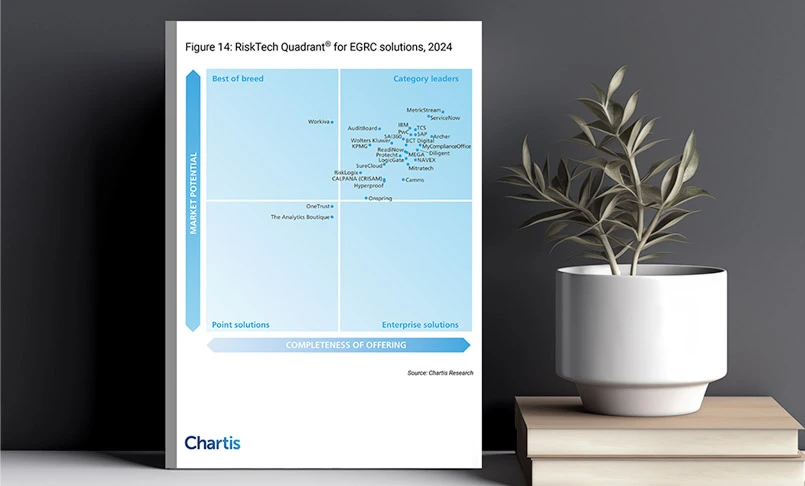Cloud Security Risks in 2025: What You Need to Know to Stay Safe
- IT Risk & Cyber Risk
- 02 May 24

Introduction
As technology rapidly develops, the cloud has become synonymous with convenience, scalability, and cost-effectiveness in data management and operations for businesses worldwide. However, this evolution comes with its own set of vulnerabilities – cloud security risks.
Cloud security risks are potential vulnerabilities or weaknesses in the cloud infrastructure that could be exploited by cyber attackers, leading to unauthorized access, data breaches, service disruptions, and compliance violations. The challenges are exacerbated by an organization’s reliance on multiple, diverse, and complex cloud environments.
The management and assessment of these cloud security risks often require collaboration among various teams, including security operations, risk management, DevOps, and IT teams. They need to continuously monitor the cloud infrastructure, assess associated risks, implement mitigation measures, and report the data and insights to the CISO.
Before diving deeper, it's crucial to differentiate between risks, threats, and challenges in the context of cloud security.
- A risk is the potential for a threat to exploit a vulnerability, adversely impacting the organization.
- A threat is anything that can exploit a vulnerability, intentionally or accidentally, and obtain, damage, or destroy an asset.
- A challenge encompasses the difficulties in securing the cloud environment, ranging from technical issues to regulatory compliance and skill gaps.
Understanding these definitions lays a clear groundwork for appreciating the complex landscape of cloud security and its implications for businesses leveraging cloud technology. This blog delves into the top cloud security risks, threats, and challenges that risk and security teams need to closely monitor.
Top 5 Cloud Security Risks
Here are the top five cloud security risks faced by organizations today:
Misconfiguration and Inadequate Change Control
One of the most pervasive cloud security risks is misconfiguration. As cloud environments become more complex and intertwined, the chances of leaving a virtual door open increase. Misconfigurations can occur at any level – from storage buckets set to public without intention to unsecured API endpoints, or improper security group settings. These missteps provide easy entry points for attackers.
Organizations often underestimate the importance of continuous vigilance and expertise required to maintain cloud configurations properly. Without adequate change control mechanisms and regular configuration audits, accidental exposure of sensitive data or resources becomes a looming risk.Insecure Interfaces and APIs
APIs and interfaces are the linchpins of cloud services, offering the means for users to interact with cloud services and for services to communicate among themselves. However, these are also prime targets for attackers due to their accessibility. Insecure APIs can lead to unauthorized access, data leakage, and service manipulation.
Ensuring API security necessitates rigorous access controls, encryption in transit and at rest, and regular audits to identify and rectify vulnerabilities.Account Hijacking
Cloud services often centralize access to resources under specific user accounts or identity credentials. If an attacker successfully hijacks these credentials, they can access sensitive data, disrupt services, and leverage the cloud resources for malicious purposes, such as launching further attacks.
Furthermore, account hijacking can lead to identity theft, financial fraud, and reputational damage for the affected organization. The ramifications of account hijacking extend beyond the immediate breach, as attackers may exploit compromised accounts for prolonged periods, causing persistent harm to the organization's operations and integrity.Insider Threats
The human element remains one of the most unpredictable variables in cloud security. Insider threats can range from negligent employees unintentionally exposing data to malicious insiders intentionally sabotaging systems or stealing information.
Given the access privileges necessary for certain roles, insiders can cause significant damage or data loss. The inherent trust placed in employees with elevated access privileges makes them potent vectors for insider threats, as they possess the capability to inflict significant damage or loss of data within the cloud environment.Data Breaches and Data Loss
Data breaches and data loss represent critical cloud security risks that can have severe consequences for organizations. Whether due to malicious attacks, accidental exposure, or insider threats, the compromise of sensitive data can lead to significant financial losses, reputational damage, and regulatory penalties.
Data breaches occur when unauthorized parties gain access to sensitive information stored in the cloud, resulting in theft, manipulation, or exposure. On the other hand, data loss refers to the unintentional destruction or unavailability of data, often due to system failures, human error, or natural disasters.
5 Recent Cloud Security Threats
Here’s a look at five recent cloud security threats that organizations across industries have been exposed to:
Zero-Day Exploits
Zero-day exploits refer to vulnerabilities in software or hardware that are unknown to the vendor and, therefore, have no patch or fix available. These vulnerabilities pose a significant threat to cloud security as attackers can exploit them to launch targeted attacks without detection. Since there is no prior knowledge of these vulnerabilities, organizations are often caught off guard, leaving their cloud environments vulnerable to exploitation.
Zero-day exploits enable cybercriminals to bypass traditional security measures, gaining unauthorized access to sensitive data or compromising cloud infrastructure.Cyberattacks
Cyberattacks encompass a broad range of malicious activities perpetrated by threat actors with the intent to compromise cloud security and disrupt business operations. These attacks can take various forms, including malware infections, phishing campaigns, ransomware attacks, distributed denial-of-service (DDoS) attacks, and man-in-the-middle (MitM) attacks.
Cybercriminals target cloud environments due to their rich troves of data and interconnected infrastructure, making them lucrative targets for exploitation.
Depending on the nature and sophistication of the attack, cyberattacks can result in data breaches, financial losses, reputational damage, and regulatory fines.Inadequate Identity and Access Management (IAM)
Effective Identity and Access Management (IAM) is the cornerstone of robust cloud security. However, inadequate IAM policies pose a significant threat, leading to unauthorized access and potential insider threats.
As organizations expand and embrace hybrid work environments, managing who has access to what becomes exponentially complex. This complexity is further exacerbated by the sheer volume of users, devices, and third-party vendors requiring access to cloud resources.
Inadequate IAM can result in excessive permissions, where users have more access rights than necessary, significantly increasing the risk of data exposure or loss should those credentials be compromised.Advanced Persistent Threats (APTs)
APTs represent a sophisticated, high-level threat wherein an attacker gains unauthorized access to a network and remains undetected for an extended period. The cloud environment, with its vast resources and data, is an attractive target for APT groups. These adversaries use advanced techniques to bypass traditional security measures, leveraging the cloud to infiltrate networks and exfiltrate sensitive information stealthily.
APTs can cause significant financial and reputational damage to organizations.
The complexity and frequency of these attacks are expected to increase, emphasizing the need for advanced threat detection and response strategies in the cloud ecosystem.Data Security Non-Compliance
Data security non-compliance refers to the failure of organizations to adhere to regulatory requirements, industry standards, or internal policies governing the protection of sensitive data in the cloud.
Non-compliance can result from inadequate security controls, improper data handling practices, or a lack of awareness regarding data protection obligations. Failure to comply with data security regulations such as GDPR, HIPAA, or PCI DSS can have severe consequences, including legal penalties, financial sanctions, and reputational damage.
Moreover, data breaches resulting from non-compliance can erode customer trust and confidence in the organization's ability to safeguard their personal information.
Top 5 Challenges in Cloud Security
Organizations face a number of challenges in their effort to strengthen the security of their cloud environment. Here are the top five challenges:
Lack of Cloud Security and Skills
One of the biggest challenges that organizations face in cloud security is the lack of knowledge and skills required to implement and maintain robust security measures. In most cases, companies do not have dedicated security teams for cloud infrastructure, which leads to a lack of awareness of potential risks and security vulnerabilities. Furthermore, companies often struggle to find qualified personnel to fill security roles due to the ongoing shortage of skilled cybersecurity professionals.
Shadow IT
Shadow IT refers to the use of unauthorized applications and services by employees without the knowledge or approval of the IT department. This practice is becoming increasingly common, and it poses significant risks to cloud security. Shadow IT often circumvents security controls and creates security vulnerabilities. Companies often have limited visibility and control over these applications, which can result in a lack of control over sensitive data.
Identity and Access Management
Organizations must implement access controls to regulate the flow of information within and outside the organization. Unfortunately, access management can be challenging to implement in a cloud environment where users and applications can access resources from multiple locations. Misconfiguration, weak passwords, and authentication failures are common vulnerabilities that cyber attackers leverage to compromise systems.
Managing a Rapidly Evolving Attack Surface
The dynamic nature of cloud environments, characterized by frequent updates, deployments, and configuration changes, creates new opportunities for cyber attackers. Traditional security measures designed for static on-premises environments may prove inadequate in the face of these dynamic threats. Also, the increasing adoption of DevOps practices and continuous integration/continuous deployment (CI/CD) pipelines further amplifies the challenge by accelerating the pace of change.
Multi-Cloud Security
The adoption of multi-cloud environments, where organizations utilize services from multiple cloud providers, introduces unique security challenges. Managing security across diverse cloud platforms requires a comprehensive understanding of each provider's security offerings, compliance requirements, and integration capabilities. Moreover, interoperability issues, data migration challenges, and differences in governance models between cloud providers can complicate security management efforts.
Tips to Strengthen Cloud Security
Here are the key measures that organizations need to implement to strengthen their cloud security posture:
- Adopt Data Encryption Practices: Encrypt your data at rest and in transit. Utilizing strong encryption algorithms helps safeguard your data from eavesdropping and unauthorized access, ensuring that even in the event of a data breach, the information remains unintelligible to the attackers.
- Regularly Monitor and Audit Cloud Environments: Continuous monitoring of your cloud environment can alert you to unauthorized activities and potential vulnerabilities. Implementing automated security solutions can help in the early detection of anomalies and enable prompt response to mitigate risks.
- Adopt a Zero-Trust Security Model: Operate under the assumption that threats can originate from anywhere, and nothing should be trusted implicitly. A zero-trust approach necessitates strict identity verification for every person and device attempting to access resources in the cloud, providing a more granular level of security control.
- Embrace a Culture of Security Awareness: Human error remains one of the weakest links in cloud security. Educating your workforce about phishing schemes, safe online practices, and the importance of using strong passwords can drastically reduce the risk of security breaches.
The future of cloud security is uncertain but exciting. As companies continue shifting more data and services to the cloud, threats are evolving rapidly. However, by staying up to date with trends, learning from past errors, and making security a significant priority, organizations can thrive in the cloud. The payoff is peace of mind knowing your data is fortified behind impenetrable defenses.
MetricStream helps organizations across industries manage IT and cyber risks and compliance processes in a holistic, proactive, and integrated manner. To learn how MetricStream can help you implement industry best practices for Cyber governance, risk management, and compliance (CyberGRC), request a personalized demo today.








